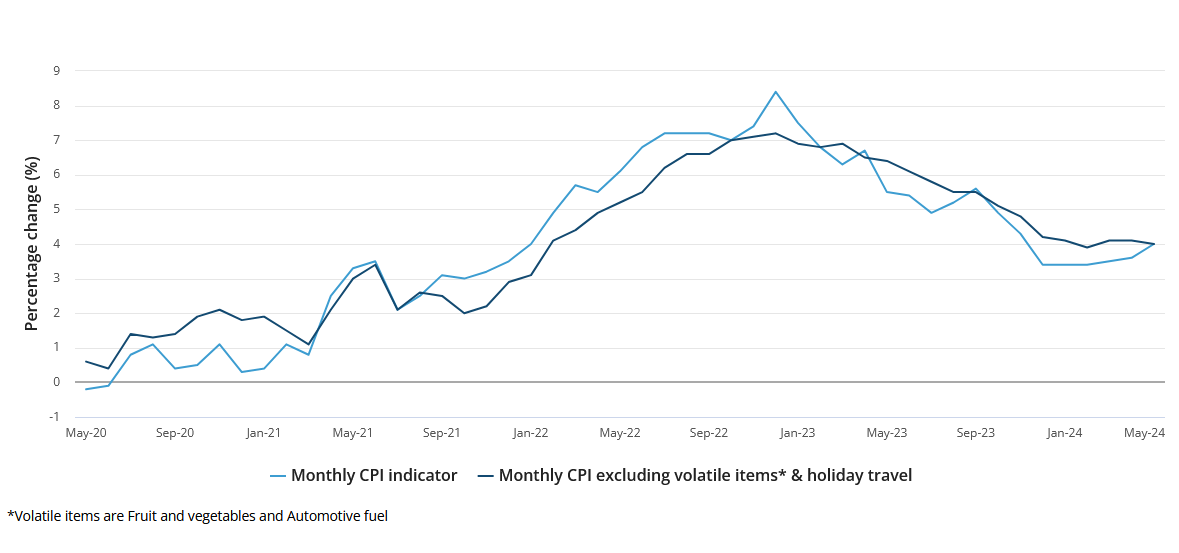RBA more likely to pull interest rates lever after 4% rise in CPI

The latest inflation figures are concerning, with the consumer price index rising 4% in the year to May 2024, increasing the likelihood that the Reserve Bank of Australia will raise the official cash rate.
The CPI was up from 3.6% in April, according to the latest data released by the Australian Bureau of Statistics on Thursday, June 26.
The biggest contributors to the May increase in CPI were housing (+5.2%), food and non-alcoholic beverages (+3.3%), transport (+4.9 %), and alcohol and tobacco (+6.7%).
The latest inflation data arrives a little over a week since the RBA board met for its June monetary policy meeting, and decided to keep the cash rate at 4.35% – a position it has held since November 2023.
In a statement on its June OCR decision, the RBA board said the economic outlook remained uncertain and recent data demonstrated that the process of returning inflation to target was unlikely to be smooth.
“The central forecasts published in May were for inflation to return to the target range of 2% to 3% in the second half of 2025 and to the midpoint in 2026,” the RBA board said.
“Since then, there have been indications that momentum in economic activity is weak, including slow growth in GDP, a rise in the unemployment rate and slower-than-expected wages growth.
“At the same time, the revisions to consumption and the saving rate and the persistence of inflation suggest that risks to the upside remain … the persistence of services price inflation is a key uncertainty.”
The RBA said the path of interest rates that would best ensure that inflation returned to target in a reasonable timeframe remains uncertain and “the Board is not ruling anything in or out”.
The next RBA board meeting to decide the cash rate is on August 6, by which time the quarterly CPI inflation figures for June will have been released.
Discussing the May CPI inflation figures, ABS head of price statistics Michelle Marquardt (pictured above) said inflation was often affected by items with volatile price changes such as automotive fuel, fruit and vegetables, and holiday travel.
“It can be helpful to exclude these items from the headline CPI to provide a view of underlying inflation, which was 4% in May, down from 4.1% in April,” Marquardt said.
All groups monthly CPI indicator, annual movement (%) Source: ABS May 2024 CPI Indicator
Source: ABS May 2024 CPI Indicator
Housing
Housing was a major contributing factor to the May inflation increase, rising 5.2% in the 12 months to May, up from 4.9% in April.
Rents were up 7.4% for the year, reflecting a tight national rental market. The annual rise in new dwelling prices remained steady at 4.9% with builders passing on higher costs for labour and materials.
Energy
Power prices rose 6.5%, up from 4.2% in April, the ABS reported.
Marquardt said out-of-pocket costs for electricity were gradually rising as the Energy Bill Relief Fund rebates were “progressively being used up by eligible households”.
“The introduction of the Energy Bill Relief Fund rebates from July 2023 has mostly offset electricity price rises from annual price reviews in the same month,” she said. “Excluding the rebates, electricity prices would have risen 14.5% in the 12 months to May 2024.
Food and drink
The CPI for food and non-alcoholic beverages was 3.3% in May, down from 3.8% in April.
The largest contributor to the annual increase in food prices was meals out and take away foods, which rose 4.2%, compared to a 5.4% rise in April.
The ABS said higher prices for grapes, strawberries, blueberries, tomatoes and capsicums drove fruit and vegetable prices to their largest annual rise since April 2023.
Food and non-alcoholic beverages, Australia, annual movement (%)
 Source: ABS May 2024 CPI Indicator
Source: ABS May 2024 CPI Indicator
Fuel
Automotive fuel prices fell 5.1% in May, the data revealed. This was the first monthly fall since January 2024, reflecting lower wholesale fuel prices.
“Despite the monthly fall in May, automotive fuel prices rose 9.3% annually, up from 7.4% in April,” said Marquardt. “The annual increase was largely due to base effects where the fall in May this year was smaller compared to the fall in May 2023.”
How likely is the RBA's next cash rate movement to be up? Share your views below



